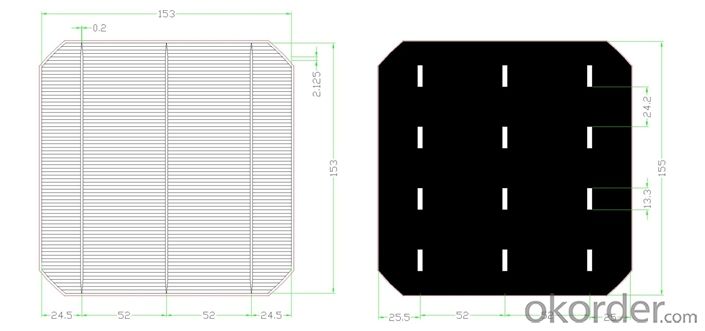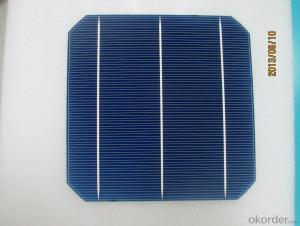Monocrystal Solar Energy Cell 156*156mm with18.8% Efficiency
- Loading Port:
- China Main Port
- Payment Terms:
- TT or LC
- Min Order Qty:
- -
- Supply Capability:
- 1000000 pc/month
OKorder Service Pledge
OKorder Financial Service
You Might Also Like

Monocrystal Solar Energy Cell
type:156M
appearance:156×1565㎜±0.5mm;diagonal:R=100mm
Main fence wide:1.4-1.5mm back electrode wide:2-2.5mm
Fence line qty:90
Cell thickness:220um±20um
Eff(%) | 18.00- 18.10 | 18.10- 18.20 | 18.20- 18.30 | 18.30- 18.40 | 18.40- 18.50 | 18.50- 18.60 | 18.60- 18.70 | 18.70- 18.80 | 18.80- 18.90 | 18.9- 19.0 | 19.1- 19.1 | 19.1- 19.2 |
Pm(W) | 4.30 | 4.33 | 4.35 | 4.37 | 4.40 | 4.42 | 4.44 | 4.47 | 4.49 | 4.52 | 4.54 | 4.56 |
Isc(A) | 8.71 | 8.73 | 8.76 | 8.77 | 8.78 | 8.82 | 8.83 | 8.85 | 8.86 | 8.88 | 8.9 | 8.93 |
Im(A) | 8.19 | 8.21 | 8.24 | 8.26 | 8.30 | 8.33 | 8.35 | 8.39 | 8.42 | 8.45 | 8.47 | 8.51 |
Voc(V) | 0.630 | 0.631 | 0.632 | 0.633 | 0.634 | 0.634 | 0.635 | 0.636 | 0.637 | 0.637 | 0.638 | 0.64 |
Vm(V) | 0.527 | 0.528 | 0.529 | 0.531 | 0.531 | 0.532 | 0.534 | 0.534 | 0.535 | 0.536 | 0.537 | 0.538 |
FF(%) | 78.6 | 78.7 | 78.8 | 79.0 | 79.2 | 79.3 | 79.5 | 79.6 | 79.8 | 80 | 80 | 80 |

remark:our company cells as per working current concentrate principle,separate the first and the second grade
Packaging & Delivery of Polycrystalline Solar Cells
Carton Box Package and Deliver by air. It should be noticed that it should be avoid of water, sunshine and moist.
Factory Picture of Solar Cells


FAQ
We have organized several common questions for our clients,may help you sincerely:
What’s price per watt?
A: It’s depends on the quantity, delivery date and payment terms of the order. We can talk further about the detail price issue. Our products is high quality with lower price level.
Can you tell me the parameter of your solar cells?
We have different series of cells with different power output, both from c-si to a-si. Please take our specification sheet for your reference.
How do you pack your products?
We have rich experience on how to pack the panels to make sure the safety on shipment when it arrives at the destination.
Can you do OEM for us?
Yes, we can.
How long can we receive the product after purchase?
In the purchase of product within three working days, We will arrange the factory delivery as soon as possible. The perfect time of receiving is related to the state and position of customers. Commonly 7 to 10 working days can be served.
- Q:What should I know about the Crystalline silicon photovoltaic cells?
- In electronics, crystalline silicon is typically the monocrystalline form of silicon, and is used for producing microchips. This silicon contains much lower impurity levels than those required for solar cells. Production of semiconductor grade silicon involves a chemical purification to produce hyperpure polysilicon followed by a recrystallization process to grow monocrystalline silicon.
- Q:Are solar cells safe for the environment?
- Yes, solar cells are safe for the environment. They generate electricity by converting sunlight into clean energy, emitting no greenhouse gases or air pollutants during operation. Additionally, the production and installation of solar cells have minimal environmental impact compared to conventional energy sources.
- Q:How are solar cells used in military applications?
- Solar cells are used in military applications to power various devices and equipment, such as communication systems, surveillance equipment, and remote sensors. They provide a reliable and renewable source of energy in remote locations where traditional power sources may be limited or unavailable. Additionally, solar cells can be integrated into portable solar panels, backpacks, or tents, allowing soldiers to charge their electronic devices and batteries on the go, enhancing their operational efficiency and reducing their reliance on fuel-based generators.
- Q:Can solar cells be used on satellites?
- Yes, solar cells can be and are commonly used on satellites as their primary source of power. Solar cells convert sunlight into electricity, providing a reliable and renewable source of energy for satellites in orbit around the Earth.
- Q:Can solar cells be used in telecommunications infrastructure?
- Yes, solar cells can be used in telecommunications infrastructure. They can provide a reliable and sustainable power source for various telecom equipment such as mobile phone towers, repeaters, and base stations. Solar cells are particularly suitable for remote or off-grid areas where access to conventional power sources is limited. Additionally, their installation can reduce operational costs and environmental impact, making them an increasingly popular choice in the telecommunications industry.
- Q:What is a good introduction of solar cell?
- In my opinion, a simple and interesting experiment would be a good start.
- Q:How do solar cells perform in regions with high levels of air pollution?
- Solar cells generally perform less efficiently in regions with high levels of air pollution. Air pollution can block sunlight and reduce the amount of light reaching the solar cells, thereby reducing their performance. Additionally, pollutants in the air can settle on the surface of the solar cells, forming a layer of dust or dirt, which further reduces their efficiency. Regular cleaning and maintenance of solar panels are necessary in polluted regions to ensure optimal performance.
- Q:How are solar cells made?
- Solar cells are typically made using a process called photovoltaic (PV) technology, which involves the assembly of semiconductor materials, usually silicon, into thin layers. The silicon is purified and then shaped into wafers, which are then treated with various dopants to create the desired electrical properties. Metal contacts are added to these wafers, and the cells are encapsulated with protective materials. When sunlight hits the cell, the photons from the sunlight create an electric field across the layers, generating electricity.
- Q:How do solar cells handle hail or other severe weather conditions?
- Solar cells are designed to withstand severe weather conditions, including hail. They are made with durable materials such as tempered glass or other shatter-resistant materials that can withstand impacts. Additionally, solar panels undergo rigorous testing to ensure their ability to withstand hailstorms and other harsh weather conditions.
- Q:Can solar cells be used in residential communities?
- Yes, solar cells can be used in residential communities. In fact, they are increasingly being adopted by homeowners as a sustainable and cost-effective alternative to traditional energy sources. Solar panels can be installed on rooftops or in open spaces within residential areas, harnessing sunlight to generate electricity for individual households or even for the entire community. This not only helps reduce reliance on fossil fuels but also enables homeowners to save on energy costs in the long run.
1. Manufacturer Overview |
|
|---|---|
| Location | |
| Year Established | |
| Annual Output Value | |
| Main Markets | |
| Company Certifications | |
2. Manufacturer Certificates |
|
|---|---|
| a) Certification Name | |
| Range | |
| Reference | |
| Validity Period | |
3. Manufacturer Capability |
|
|---|---|
| a)Trade Capacity | |
| Nearest Port | |
| Export Percentage | |
| No.of Employees in Trade Department | |
| Language Spoken: | |
| b)Factory Information | |
| Factory Size: | |
| No. of Production Lines | |
| Contract Manufacturing | |
| Product Price Range | |
Send your message to us
Monocrystal Solar Energy Cell 156*156mm with18.8% Efficiency
- Loading Port:
- China Main Port
- Payment Terms:
- TT or LC
- Min Order Qty:
- -
- Supply Capability:
- 1000000 pc/month
OKorder Service Pledge
OKorder Financial Service
Similar products
New products
Hot products
Related keywords



























